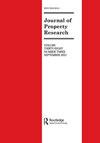限制与便利:业主协会对房地产市场化的不同影响
IF 2.3
Q2 URBAN STUDIES
引用次数: 3
摘要
摘要共同利益开发项目(CID)或城市规划开发项目(PUD)可以包括多种物业类型,如公寓、联排别墅、合作社和独栋住宅。许多此类开发项目由房主协会(HOA)私人管理,并由由社区房主组成的HOA董事会管理。尽管这些社区及其管理机构因其繁重的规则、条例和排他性做法而受到广泛批评,但许多人认为,为其成员提供的便利设施、福利和公用事业为房主提供了很大程度的满足感。事实上,HOA的目的之一是通过创造一个负外部性最小的环境来维护和提高房屋价值。尽管人们普遍认为HOA确实增加了价值,但这些协会也产生了一些有争议的争议。本文考察了HOA对适销性的影响,以实证方式揭示买家认为HOA是有益的还是负担沉重的问题。结果表明,HOA对价格、营销时间和销售概率的影响甚至不跨价格段,即使在控制了封闭社区的存在后也存在。本文章由计算机程序翻译,如有差异,请以英文原文为准。
Restrictions versus amenities: the differential impact of home owners associations on property marketability
ABSTRACT Common-interest developments (CIDs) or planned urban developments (PUDs) can include a multitude of property types such as condos, townhomes, coops and single-family residences. Many such developments are privately governed by a homeowners’ association (HOA) and managed by an HOA board of directors comprised of community homeowners. While such communities and their governing bodies have been widely criticised for their onerous rules, regulations and exclusionary practices, many argue that the amenities, benefits and utility afforded to its members provide a large degree of satisfaction for homeowners. In fact, one of the purposes of an HOA is to preserve and enhance home values by creating an environment with minimal negative externalities. Although it is generally assumed that an HOA does add value, these associations have also generated a number of controversial disputes. This paper examines the effects of an HOA on marketability to empirically shed light on the question of whether buyers find HOAs to be beneficial or burdensome. The results show that the impact of the HOA on price, marketing time and probability of sale are not even across price segments and exist even after controlling for the presence of gated communities.
求助全文
通过发布文献求助,成功后即可免费获取论文全文。
去求助
来源期刊

Journal of Property Research
URBAN STUDIES-
CiteScore
3.80
自引率
5.30%
发文量
13
期刊介绍:
The Journal of Property Research is an international journal. The title reflects the expansion of research, particularly applied research, into property investment and development. The Journal of Property Research publishes papers in any area of real estate investment and development. These may be theoretical, empirical, case studies or critical literature surveys.
 求助内容:
求助内容: 应助结果提醒方式:
应助结果提醒方式:


